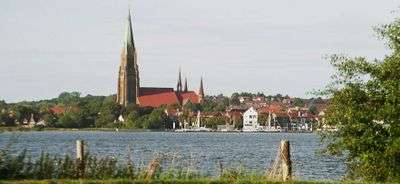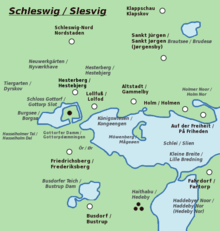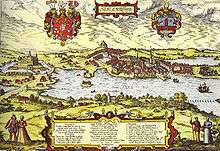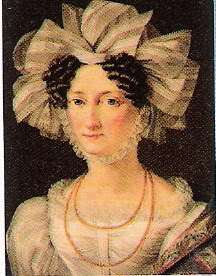Schleswig, Schleswig-Holstein
| Schleswig Slesvig | ||
|---|---|---|
 St. Peter's Cathedral | ||
| ||
 Schleswig Slesvig Location of Schleswig Slesvig within Schleswig-Flensburg district | ||
| Coordinates: 54°31′05″N 9°34′13″E / 54.51806°N 9.57028°ECoordinates: 54°31′05″N 9°34′13″E / 54.51806°N 9.57028°E | ||
| Country | Germany | |
| State | Schleswig-Holstein | |
| District | Schleswig-Flensburg | |
| Government | ||
| • Mayor | Arthur Christiansen | |
| Area | ||
| • Total | 24.3 km2 (9.4 sq mi) | |
| Elevation | 1 m (3 ft) | |
| Population (2016-12-31)[1] | ||
| • Total | 24,773 | |
| • Density | 1,000/km2 (2,600/sq mi) | |
| Time zone | CET/CEST (UTC+1/+2) | |
| Postal codes | 24837 | |
| Dialling codes | 04621 | |
| Vehicle registration | SL | |
| Website | www.schleswig.de | |
Schleswig (German pronunciation: [ˈʃleːsvɪç]; Danish: Slesvig; South Jutlandic: Sljasvig; archaic English: Sleswick; Low German: Sleswig) is a town in the northeastern part of Schleswig-Holstein, Germany. It is the capital of the Kreis (district) Schleswig-Flensburg. It has a population of about 27,000, the main industries being leather and food processing. It takes its name from the Schlei, an inlet of the Baltic sea at the end of which it sits, and vik or vig which means “bay” in Old Norse and Danish. Schleswig or Slesvig therefore means “bay of the Schlei”.
Geography

The city lies at the western end of the Schlei Förde, which separates the two peninsulas of Angeln and Schwansen, and is on the western edge of the Schleswig-Holstein Uplands on the transition to the Geest country. The urban area ranges from 0 to 20 m (66 ft) above sea level. Brautsee (lake) is in the town.
The nearest major cities are Flensburg, Husum and Kiel. Autobahn 7 runs immediately west of the city. Highways 76 and 77 end in Schleswig and B 201 runs to the north of the town. Schleswig station is a stop for InterCity and Intercity-Express trains and is on the Hamburg–Neumünster–Flensburg and Husum–Kiel lines.
Climate
The climate is humid and maritime. The annual mean temperature is 8 °C and precipitation averages 925 mm.
| Climate data for Schleswig, Germany | |||||||||||||
|---|---|---|---|---|---|---|---|---|---|---|---|---|---|
| Month | Jan | Feb | Mar | Apr | May | Jun | Jul | Aug | Sep | Oct | Nov | Dec | Year |
| Average high °C (°F) | 2 (36) |
3 (37) |
6 (43) |
10 (50) |
16 (61) |
19 (66) |
20 (68) |
20 (68) |
17 (63) |
13 (55) |
7 (45) |
4 (39) |
11 (53) |
| Daily mean °C (°F) | 0 (32) |
1 (34) |
3 (37) |
6 (43) |
11 (52) |
15 (59) |
16 (61) |
16 (61) |
13 (55) |
9 (48) |
5 (41) |
2 (36) |
8 (47) |
| Average low °C (°F) | −1 (30) |
−1 (30) |
0 (32) |
3 (37) |
7 (45) |
10 (50) |
12 (54) |
12 (54) |
10 (50) |
7 (45) |
3 (37) |
0 (32) |
5 (41) |
| Average precipitation mm (inches) | 79 (3.11) |
50 (1.97) |
61 (2.4) |
55 (2.17) |
61 (2.4) |
71 (2.8) |
92 (3.62) |
87 (3.43) |
86 (3.39) |
90 (3.54) |
105 (4.13) |
88 (3.46) |
925 (36.42) |
| Average precipitation days | 13 | 10 | 12 | 10 | 9 | 10 | 12 | 11 | 11 | 12 | 15 | 13 | 138 |
| Mean monthly sunshine hours | 42 | 67 | 103 | 168 | 226 | 231 | 213 | 215 | 145 | 98 | 51 | 40 | 1,599 |
| Source: The Weather Network [2] | |||||||||||||
History

The Viking settlement of Hedeby, located south of the modern town, was first mentioned in 804. It was a powerful settlement in the Baltic region, dominating the area for more than 200 years. In 1050, following several destructions, the population was moved to the opposite shore of the Schlei, becoming the city of Schleswig. In 1066 Hedeby was finally destroyed, and Schleswig remained as a part of the Danish kingdom.
In 1544, Gottorf Castle became the residence of the local rulers. The dukes of Gottorf were vassals of the Danish kings and ruled over much of present-day Schleswig-Holstein. In 1721, when the Great Northern War ended, the dukes of Gottorf lost their power and their land became Danish crown land. After the Second Schleswig War (1864), Schleswig was annexed by the Kingdom of Prussia.
Sights
- Schleswig Cathedral (1134), with the tomb of King Frederick I of Denmark
- Gottorf Castle (built 1161), former residence of the dukes, with the baroque Neuwerk garden, containing a replica of the Globe of Gottorf
- Holm: old fishing village at the Schlei shore
- Hedeby, Viking settlement
Notable residents

.jpg)
.jpg)
Je.Bauer.jpg)

Up to 1850
- Christian III of Denmark (1503 in Gottorp – 1559) King of Denmark [3] from 1534 until his death
- Georg Calixtus (1586 in Medelby – 1656) Lutheran theologian [4]
- Johan Ross the Elder (1695–1773) Swedish painter
- Adolf Frederick, King of Sweden (1710 in Gottorp– 1771) King of Sweden [5] from 1751 until his death
- Friedrich August, Duke of Holstein-Oldenburg (1711 in Gottorp - 1785) was Duke of Oldenburg
- Asmus Jakob Carstens (1754–1798) Danish-German painter, [6] committed to Neoclassicism
- Princess Louise Caroline of Hesse-Kassel (1789 in Gottorp – 1867) matriarch of the House of Schleswig-Holstein-Sonderburg-Glücksburg
- Carl Andreas August Goos (1797 - 1855) painter working in history painting, genre painting and portrait painting.
- Herman Wilhelm Bissen (1798–1868) sculptor
- Friedrich Bernhard Westphal (1803 - 1844) German-Danish genre painter and illustrator
- Karl Friedrich Wilhelm Jessen (1821–1889) botanist
- Friedrich Krichauff (1824–1904) politician [7] in colonial South Australia
- Casper Petersen (1826 in Mielberg – 1906) was an American schoolteacher, businessman, farmer and politician; emigrated 1851
- Christian Andreas Victor Hensen (1835 – 1924) was a German zoologist (planktology)
- Edward Selig Salomon (1836–1913), General in the American Civil War and Governor of Washington Territory (1870–1872)
- Ove H. Berg (1840–1922) was an American politician and businessman, emigrated to the US in 1881
- Julius Friedrich Theodor Engel (1842-1926) judge and politician
1850 to date
- Jens Jensen (1860–1951), landscape architect
- Johannes Friedrich Hans von Seeckt (1866–1936) military officer
- Carl L. Rasch (1866–1961) was a United States federal judge
- Robert Edouard Moritz (1868–1940) mathematician, emigrated to USA aged 12, head of the maths at the University of Washington
- Ulrich von Brockdorff-Rantzau (1869–1928) politician and diplomat, first Foreign Minister of the Weimar Republic, German Ambassador to the USSR from 1922 to 1928
- Christian Hansen (1885 – 1972) general
- Hermann-Bernhard Ramcke (1889–1968), General of paratroop forces
- Peter Voß (1891 in Fiefhusen – 1979) film actor
- Augustus Dudley Peters (1892–1973) British literary agent
- Bernhard Rogge (1899–1982) naval officer
- Carsta Löck (1902 in Deezbüll – 1993) film actress
- Bernd Kröplin (born 1944) engineer and academic.
- Ralf Rothmann (born 1953), novelist
- Thomas Heberer (born 1965) is a jazz trumpeter, cornetist, keyboardist and composer
- Ekkehard Wölk (born 1967) pianist, arranger, and composer
sport
- Karl Schultz (born 1937) equestrian and Olympic medalist
- Herbert Blöcker (1943–2014) equestrian and 3-time Olympic medalist
- Jobst Hirscht (born 1948) former athlete who competed mainly in the 100 metres
- Hole Rößler (born 1949) modern pentathlete, competed for West Germany at the 1972 Summer Olympics
- Jan-Ingwer Callsen-Bracker (born 1984), footballer
References
- ↑ "Statistikamt Nord – Bevölkerung der Gemeinden in Schleswig-Holstein 4. Quartal 2016] (XLS-file)". Statistisches Amt für Hamburg und Schleswig-Holstein (in German).
- ↑ "Climate Statistics for Schleswig, Schleswig-Holstein, Germany". Retrieved August 20, 2012.
- ↑ 1911 Encyclopædia Britannica, Volume 6, Christian III. retrieved 23 March 2018
- ↑ 1911 Encyclopædia Britannica, Volume 5, Calixtus, Georg retrieved 23 March 2018
- ↑ 1911 Encyclopædia Britannica, Volume 1, Adolphus Frederick retrieved 23 March 2018
- ↑ 1911 Encyclopædia Britannica, Volume 5, Carstens, Armus Jacob retrieved 23 March 2018
- ↑ The Dictionary of Australasian Biography, Krichauff, Hon. Friedrich Edouard Heinrich Wulf retrieved 23 March 2018
External links
| Wikimedia Commons has media related to Schleswig. |
| Wikivoyage has a travel guide for Schleswig. |
- Municipal website (in German)



